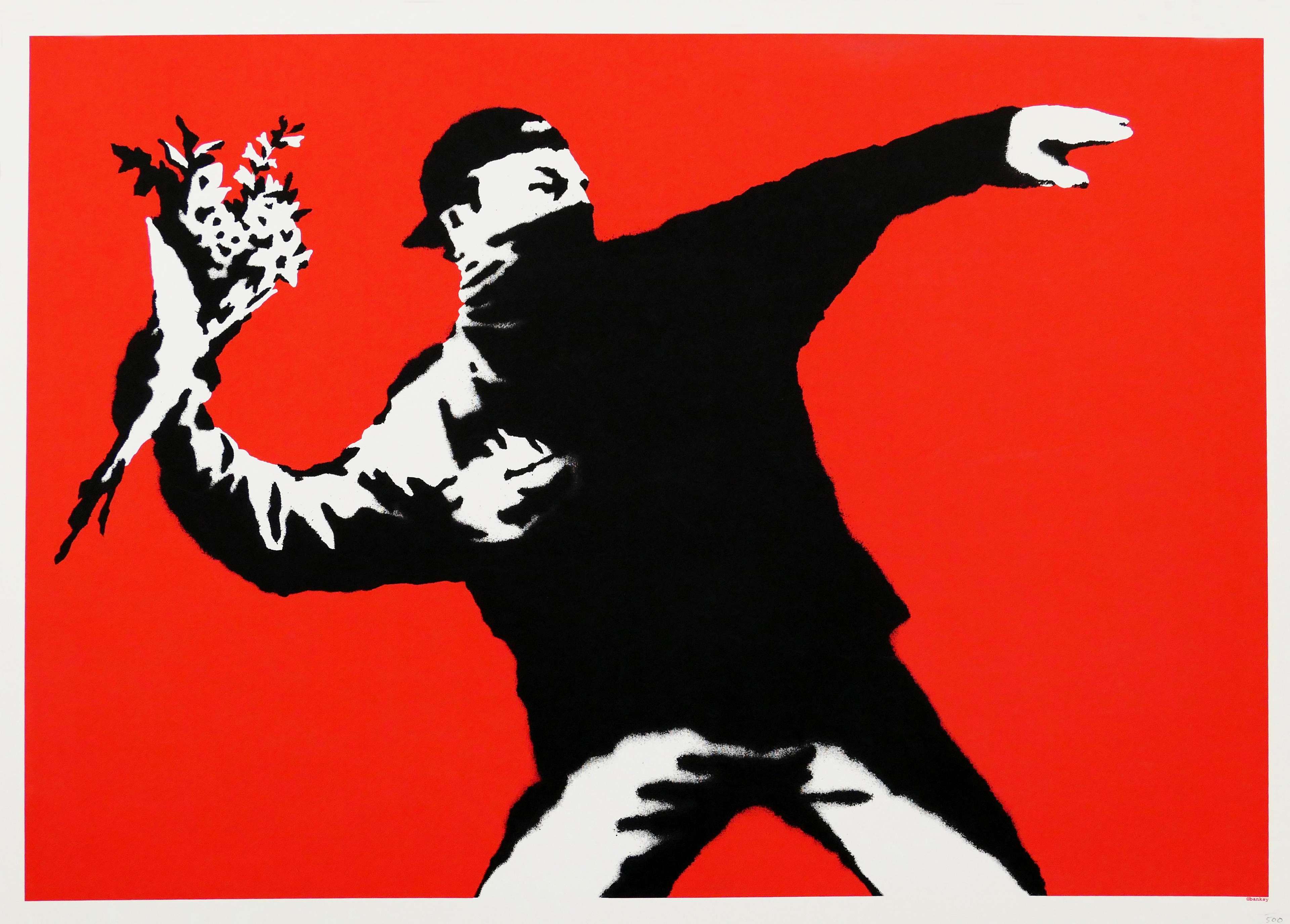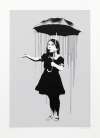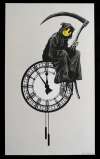The Expert Guide To Selling A Banksy

Market Reports
Banksy, the Bristol-born artist, rose to prominence in the early 1990s, quickly becoming a cultural enigma - neither fully inside nor outside the art world, and that’s part of what makes his work so compelling. His market remains distinct, shaped by the absence of traditional gallery representation. If you’re looking to sell a Banksy print, this guide offers essential insights and expert advice to help you navigate the process.
MyArtBroker’s approach to selling Banksy has been recommended by Street Art Bio in their article ‘How to Sell a Banksy: Best in Class‘.
Is Now A Good Time To Sell A Banksy print?
While overall sales volumes for Banksy prints have fluctuated in recent years, the first half of 2025 has shown encouraging signs for sellers. The June Editions sale at Phillips confirmed that demand for his most iconic works remains strong. Earlier in the year, January’s auction season saw continued momentum at the lower- to mid-value level, unsigned examples - indicating healthy demand for more accessible entry points into Banksy’s market.
Despite lower lot volumes, the total value of Banksy print sales in H1 2025 rose year-on-year, pushing the average sale price to £38,400 - up from £25,300 during the same period in 2024. As MyArtBroker’s Helena Poole noted in Metro, “Banksy’s market is uniquely driven by demand for his most iconic and widely recognised works… while these works have come down in value slightly, they continue to attract buyers far beyond traditional art hubs like New York, London and Asia.” Although prices remain below their 2021–22 peak, the data points to a stabilising market with strong opportunities for sellers - particularly when listing works with proven visibility, strong provenance, or cultural relevance.
Sotheby’s Sells Crude Oil (Vettriano) for £4.2 Million
During the March marquee sales, Crude Oil (Vettriano) - consigned by Blink-182’s Mark Hoppus - was a headline lot in Sotheby’s Contemporary Sale, achieving £4.2 million and ranking among Banksy's highest auction results to date. Appearing at auction for the first time and presented in excellent condition, the work attracted strong interest thanks to its celebrity provenance, its inclusion in Banksy’s coveted Crude Oil series, and its exhibition history tied to the artist’s infamous Notting Hill show. In a more measured market, the result reaffirmed that rare, early Banksy originals continue to achieve premium prices and hold strong relevance today.
Return to Street Roots: London Zoo, Madonna and Child, and Marseille Murals
Banksy has remained publicly active over the past 12 months, reinforcing the link between his street-level interventions and market confidence. In summer 2024, his week-long London Zoo mural drop - revealing one new artwork per day - drew global press and commentary, including coverage from Sky News, where we discussed the renewed visibility it brought to his market.
This was followed in December by a timely Christmas post on his official Instagram featuring Mother and Child - a work many speculated was a reflection on religion and war. Then in early 2025, I Want to Be What You Saw in Me appeared on a wall in Marseille. MyArtBroker was cited in The Metro for commentary on the mural’s emotional tone and significance within Banksy’s evolving street practice.
While speculation around the meaning and timing of Banksy’s recent Instagram posts and public murals continues, neither the artist nor Pest Control has confirmed anything - maintaining the kind of ambiguity Banksy-enthusiasts value most. This carefully curated silence sustains cultural relevance and market intrigue. As seen with Game Changer in 2020 or the Ukraine murals in 2022, such moments often reignite buyer interest, offering a valuable backdrop for sellers considering when to bring a work to market.
Banksy Vs. The Art Market
This pattern of sudden, unexplained appearances is nothing new and has always been central to Banksy’s practice - and a key reason his market remains so responsive. His public interventions often reignite debate and collector interest, reinforcing the tension between anti-establishment messaging and high commercial value. In 2006, Morons satirised the auction world; in 2018, Girl With Balloon self-destructed moments after selling at Sotheby’s for £1.04 million - later reappearing as Love is in the Bin and reselling for £18.5 million. Following the £9.9 million sale of Devolved Parliament in 2019, Banksy posted a Robert Hughes quote to Instagram lamenting how art had become “a substitute for a bank account.”
Together, these moments create the framework of a market that collectors closely follow - not despite the unpredictability, but because of it. It’s this ongoing tension and visibility that sustains interest in his prints and generates consistent opportunities for resale. As discussed in this YouTube interview, where MyArtBroker appeared on The Spectator, Banksy’s unannounced interventions are not only expected - they’re embraced. The lack of explanation is part of the appeal, forming a key characteristic of both his practice and his market.
Rising Values for Banksy's Iconic Editions
Despite the broader contraction in Banksy’s print market since its 2021 peak, works from collections like Girl With Balloon, Kate Moss, and Flower Thrower have shown a stabilising trajectory - underscoring sustained demand for his most iconic and culturally recognisable images.
Girl With Balloon remains the barometer for Banksy’s market. After peaking at £328,000 in 2021 and adjusting to £84,940 in 2023, average values rebounded to £188,051 in 2024, before settling at £107,500 in 2025. This still reflects a 26% increase from its 2023 low, despite ongoing volatility. Our Girl With Balloon market report offers a full breakdown of performance by year, format, and signature status
Kate Moss has seen a narrower value range, averaging £170,760 in 2021, climbing slightly in 2022, then softening to £80,000 in 2024 before edging back to £95,000 in 2025. Flower Thrower - long favoured for its visual impact and symbolism - peaked in 2022 at £206,610 before stabilising to £95,000 in 2025, maintaining steady appeal across editions.
While values have eased from their speculative highs, recent trends suggest Banksy’s market is entering a more stable and mature phase. Demand remains strong for recognisable, high-visibility works - particularly those in good condition with Pest Control certification. As fewer Banksy prints come to market, we have to assume that collectors are holding onto them, contributing to a growing sense of scarcity. Even in a more selective climate, these factors continue to support value for sellers. For deeper insights into current buyer behaviour, download The Collectors’ Guide to the Print Market in 2025.
How To Estimate The Value Of Your Banksy Print
Satirical, Political & Exhibition Prints: What Drives Desirability
Banksy’s print market follows clear demand patterns, with thematic content playing a central role in shaping value. Works with stark political commentary - such as Napalm, Toxic Mary, and Christ With Shopping Bags - tend to attract a more niche collector base drawn to their confrontational tone. While not necessarily undervalued, they appeal to buyers interested in the more provocative side of Banksy’s message.
In contrast, satirical prints like Donuts, Jack & Jill, and No Ball Games offer a more accessible take on consumerism and social critique, resonating with a wider audience. Similarly, the Barely Legal print set - six works originally released in conjunction with Banksy’s 2006 Los Angeles exhibition - blends irreverence with institutional recognition. While each carries different value depending on whether it is signed, unsigned, or hand-finished, the association with this key moment in Banksy’s early market has lasting appeal.
Banksy’s Highest Valued Prints
The top tier of Banksy’s print market is dominated by editions based on his most iconic murals, such as Girl With Balloon, Choose Your Weapon, NOLA, Flower Thrower, and Rude Copper. These works typically achieve the highest values across both public and private sales.
Auction Record for a Banksy Print
Artist Proofs (APs) - which make up a small fraction of certain editions - often sell at a premium due to their scarcity and distinctive traits like hand-finishing, unique colourways, or annotations. The record price for a Banksy print remains Girl With Balloon (gold) (AP), which sold for £1.1 million in 2021 - well above its £600,000 high estimate.
Signed prints consistently outperform unsigned ones, but unsigned versions still hold strong investment potential. Issued with Pest Control certificates, they appeal to a wide range of buyers entering at different price points.
Why Pest Control Authentication Matters for Banksy Prints
But! Authentication is critical. A Pest Control certificate accounts for up to half of a print’s market value - without it, many buyers won’t engage. Early editions, test proofs, and works released through Pictures on Walls (POW) often carry historical weight, but their performance on the secondary market hinges on being properly verified. Provenance matters - but certification is essential.
Browse Banksy works on the Trading Floor and learn more about long-term performance in the Banksy Investment Guide.
Tracking Market Trends and Colourway Impact
The chart above examines the colour variations of Choose Your Weapon, with bubble size indicating the number of works sold per year. It highlights how supply varies significantly by colourway - a factor that directly influences rarity and pricing. More frequently traded colours tend to support consistent demand, while scarcer editions can command premiums when well-timed to market.
In Choose Your Weapon, which exists in over 20 colour variants, colourway has a major impact on value. Bright pink, bright purple, and dark blue appear regularly at auction and often sell above £250,000. Others are far more rare: Choose Your Weapon (fluoro green), for example, has only surfaced once publicly and holds the record for the series at £302,400.
Understanding how your specific print compares - by colour, condition, and sales history - is key to setting informed expectations and strategically timing your sale.
Looking To Sell Your Banksy Print?
Request a free valuation with our team to assess where your print sits in today’s market.
Is Your Banksy Signed Or Unsigned?
The chart above breaks down signed and unsigned Banksy print sales from 2020 through mid-2025, showing that while signed editions consistently achieve higher overall values, unsigned works remain a vital part of the market. The peak came in 2021, with signed prints reaching £18.6M and unsigned close behind at £14.7M. Though volumes have since declined, both segments continue to attract active demand. Signed prints, typically limited to around 150 editions, command premiums due to their rarity and the presence of Banksy’s distinctive uppercase signature - either in pencil, crayon, or integrated into the artwork. In contrast, unsigned editions are usually in runs of 600 to 750 and may include stamped signatures in black, red, or white, or be numbered only. Pest Control certification is issued for both, playing a critical role in ensuring legitimacy and buyer confidence.
For sellers, the key takeaway is that both signed and unsigned editions remain active parts of the market, with performance increasingly shaped by edition scarcity, certification, and evolving collector behaviour. While the market has moved beyond the speculative highs of 2021, today’s conditions favour well-positioned works and considered pricing - offering a more stable and strategic environment in which to transact. For a detailed overview of the different ways to approach a sale - whether through auction, private sale, or tailored placement - explore our How to Sell in the Print Market guide.
 Pest Control © Pest Control
Pest Control © Pest ControlHow To Authenticate A Banksy
Authenticating a Banksy print is essential to preserving its value and determining it's provenance. Since 2009, this process has been managed by Pest Control - the artist’s own authentication body, set up in response to the flood of fakes and unauthorised sales that accompanied Banksy’s rapid rise in popularity. Uniquely, it remains the only entity authorised to verify genuine Banksy works, making it a cornerstone of his market.
Pest Control issues certificates of authenticity (COAs) for prints and originals, but will not authenticate street works or offer valuations. Its purpose is to protect Banksy’s intellectual property, control distribution, and moderate speculation. As the only artist-managed authentication body of its kind, it reflects the subversive brilliance that defines Banksy’s practice, offering a rare level of artist oversight in an otherwise opaque secondary market. Without a COA, a Banksy print loses significant resale value; most auction houses and reputable platforms won’t recognise the value in the work without one.
If you’re planning to sell, it’s essential to retain all purchase documentation, as this will be required for Pest Control to verify the work. To learn more about the process, visit our guide on verifying Banksy prints and Pest Control authentication and get in touch with us for more information on the process.
Assessing The Condition Of Your Banksy Print
Condition is also a key factor in determining a Banksy print’s value - especially as many early editions, produced in the early 2000s, were created before the artist’s market fully took shape. At the time, resale potential was uncertain, and prints often changed hands informally, sometimes even gifted - echoing practices from the American Pop era. Originally sold for as little as £50–£100, many of these works were stored or framed casually, resulting in condition issues that now affect their value, despite some reaching six-figure sums.
Today, pristine condition is crucial to maintaining long-term value. During our OPEN EDITION panel on Preserving Value, experts noted that some early Banksy prints were produced on acidic paper - suggesting these works may not have been intended as enduring collectibles. This material choice, while conceptually fitting, presents conservation challenges, reminding collectors that value is tied not just to provenance but also to physical integrity.
The same panel also pointed to the irony of a market that demands “pristine” street art, despite its raw, rebellious origins. Yet as values have grown, so too have expectations around preservation. Many early prints were once kept in inexpensive clip frames; now, with values in the six figures, proper conservation - such as float mounting for deckled edges - has become essential.
At MyArtBroker, our team offers free, no-obligation valuations and works with trusted conservation specialists who can advise on restoration where appropriate. To learn more or get support, visit The Directory for expert-led services across collecting, framing, and care.
Ways to Sell with MyArtBroker
How a Free Valuation Works
At MyArtBroker, our specialists offer free, data-led valuations, providing clarity and confidence in today’s market. Through our online Trading Floor, sellers gain access to real-time insights into works by the artist they wish to sell - including those currently in demand, listed for sale, or actively wanted - making our valuations fully transparent and market-aligned.
MyPortfolio, our complimentary collection management tool, also gives sellers access to our full print market database. This includes past auction histories, hammer prices, and seller returns for your specific work. In a market that’s constantly shifting, access to this kind of historical data - often paywalled elsewhere - is invaluable. Combined with expert guidance, it equips you to make informed decisions around value and timing.
Our approach is tailored to align with the unique attributes of each artwork, and offer optimal results:
How a Private Sale Works
Unlike general peer-to-peer platforms, which often lack the expertise and structure required for high-value artworks, MyArtBroker facilitates private sales with full transparency, legal protection, and logistical support. We charge sellers 0% commission and instead take a small fee from the buyer - covering marketing, shipping, and insurance at no cost to the seller.
We operate as a lean, specialist platform, meaning lower overheads and better returns for our clients. Revenue is generated solely through individually negotiated buyer-side fees. By focusing on works valued above £10,000, we ensure your artwork receives the tailored attention it deserves - maximising visibility, care, and ultimately, the final sale result. For lower-value works, we offer honest, no-obligation advice on the most suitable route to market.
Advisory and Recommendations
In cases where a work may not align with our existing collector network - due to value, medium, or condition - we draw on a wider circle of trusted partners to support a successful sale. This approach is tailored to the unique attributes of each artwork, ensuring it reaches the right audience and performs as strongly as possible in today’s selective market.
Recommendations are made on a case-by-case basis and are part of our free advisory service. Whether we manage the sale directly or point you toward the best route, our goal is to help you find the right buyer and the right moment for your artwork.
Why Sell Your Banksy With MyArtBroker?
A Dedicated Specialist
In today’s evolving market, online private transactions are increasingly preferred for their discretion and flexibility. Selling through MyArtBroker connects you with a dedicated sales expert who will guide you through valuation, assess current demand, and provide access to our proprietary art tech tools. This allows you to make informed decisions without the risks of public auction.
Request a free valuation or speak with our team today.
Minimise Risk
Transparency and security are central to every sale at MyArtBroker. We carry out rigorous due diligence, verifying provenance and authenticity with support from trusted internal and external experts. Unlike public auctions - where unsold works can impact market perception - private sales protect the value of your artwork and offer faster liquidity, free from rigid sale calendars and public exposure.
0% Seller's Fess, 100% Of The Time
We offer complimentary valuations and charge no fees to sellers - 100% of the time. By keeping overheads low and investing in smart digital tools and targeted outreach, we help maximise visibility and returns.
Our team specialises in high-value, limited-edition prints and has deep knowledge of the Banksy market. Founder Joe Syer and our senior sales team have been active in Banksy’s print market since before its boom, giving us a long-standing perspective on trends, timing, and value.
Hear Joe and our experts discuss the latest shifts in the Banksy market in our panel discussion.
Our Network
Our live Trading Floor connects over 30,000 collectors globally, many of whom are actively seeking specific Banksy prints. This real-time online marketplace offers a unique advantage - allowing you to see current demand and pricing trends as they happen, a feature not available on other platforms.
This data-driven approach supports smoother, more informed transactions and helps sellers make timely decisions. It’s part of how we’ve helped thousands of collectors navigate the market confidently.
To explore insights across top-performing blue chip artists, browse our latest market reports.
Banksy Collection Management With MyPortfolio
As the art market becomes increasingly data-driven, tools like MyPortfolio play a growing role in how collectors manage their collections and assess value. Developed by MyArtBroker, MyPortfolio offers access to a comprehensive print market database with over 50,000 global auction records, supporting a more informed and transparent approach to ownership and resale.
At the heart of the platform is SingularityX, MyArtBroker’s proprietary algorithm, which draws on both public auction and private sales data to generate real-time, artwork-specific valuations. Variables such as condition, colourway, and edition type are factored in - offering a more nuanced view than standard price tracking can provide. As outlined in our May 2025 Market Editor Report, access to this level of granularity is becoming essential as private sales grow and price transparency becomes more central to how collectors make decisions.
Tools like MyPortfolio don’t replace expertise - they enhance it. When paired with specialist insight, these technologies offer a clearer picture of how works like Banksy’s are performing over time, when to sell, and what to expect. In an increasingly digital market, the combination of data, market experience, and tailored intelligence is becoming the new standard for responsible collection management.













